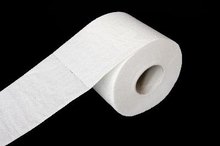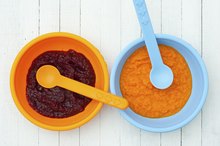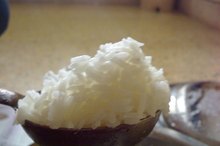Diarrhea Color in a Baby
Diarrhea is an unfortunate fact of life for babies and children at various times in their lives. The most common cause of diarrhea is viral gastroenteritis, also known as stomach flu, but diarrhea can also result from food poisoning, certain medications and certain medical conditions. In some cases, the color of the diarrhea can help identify its cause and how serious it is. Because diarrhea can quickly cause dehydration in babies, seek medical attention for diarrhea lasting more than a couple of days or accompanied by fever and vomiting.
If you are experiencing serious medical symptoms, seek emergency treatment immediately.
Yellow-brown
After the first few days of life, a baby's feces is generally a yellow-brown color, reflecting the proper digestion of his or her food. Yellow-brown diarrhea typically means that baby has some sort of a stomach bug or sensitivity to a food or medication. For breastfed babies, the sensitivity could be to a food or medication you are consuming. Try an elimination diet where you remove the most likely offender, which is often dairy, for a few weeks and see if the diarrhea returns after reintroducing the food.
- After the first few days of life, a baby's feces is generally a yellow-brown color, reflecting the proper digestion of his or her food.
- For breastfed babies, the sensitivity could be to a food or medication you are consuming.
Green
Can Tomato or Vegetable Juice Change a Bowel Movement to Red?
Learn More
In a nursing baby, green diarrhea may indicate the baby is consuming too much of the watery fore milk, which is released at the beginning of a nursing session, and not enough rich hind milk, which comes at the end. Make sure she empties one breast before switching to the other breast. In an older baby, green diarrhea could indicate food passing through the digestive tract faster than normal, so that the bile did not have a chance to turn from green to brown. This is common with stomach viruses.
- In a nursing baby, green diarrhea may indicate the baby is consuming too much of the watery fore milk, which is released at the beginning of a nursing session, and not enough rich hind milk, which comes at the end.
- In an older baby, green diarrhea could indicate food passing through the digestive tract faster than normal, so that the bile did not have a chance to turn from green to brown.
Orange
Food passing through the body faster than usual may also be eliminated with an orange hue, indicating insufficient exposure to bile. Babies that eat significant amounts of orange foods, such as carrots and yams, can also expel orange stool. Orange diarrhea may indicate a sensitivity to one of these orange foods. Eliminating orange foods temporarily and then checking for a return of diarrhea after reintroducing them one by one can help pinpoint the cause.
- Food passing through the body faster than usual may also be eliminated with an orange hue, indicating insufficient exposure to bile.
- Babies that eat significant amounts of orange foods, such as carrots and yams, can also expel orange stool.
Red or Black
Dark Stool in Infants
Learn More
As with orange stool, red-colored stools can sometimes result from something red your baby ate or drank 4. Red spots in the stool, however, could indicate blood. Most often, blood in the stool is caused by a tiny tear in the rectum that heals itself. Bloody stool or diarrhea can also indicate an allergy, often to diary or to formula based on cow's milk. Dark red or black stool can suggest bleeding higher up in the digestive tract. Because bleeding along the digestive tract can also hasten the passage of food, it can also result in red diarrhea. Due to the potential for a serious problem, red or black stool or diarrhea should be brought to the immediate attention of the pediatrician.
- As with orange stool, red-colored stools can sometimes result from something red your baby ate or drank 4.
- Bloody stool or diarrhea can also indicate an allergy, often to diary or to formula based on cow's milk.
Pale or Gray
Pale or gray stool or diarrhea could indicate a problem in the biliary system, which includes the gallbladder, liver and pancreas. Because bile turns stool brown, inadequate amounts of bile can result in pale or gray stools. One possible condition in babies is biliary atresia, where the bile duct does not form properly. Insufficient bile is also often associated with jaundice, or yellowing of the baby's skin and eyes. Seek prompt medical attention if the baby passes pale or gray stool or diarrhea.
- Pale or gray stool or diarrhea could indicate a problem in the biliary system, which includes the gallbladder, liver and pancreas.
Related Articles
References
- MedlinePlus: Diarrhea
- BabyCenter.com: What's the Normal Color of a Breastfed Baby's Bowel Movement?
- Parents.com: Inside Baby's Diaper - Stool Color
- MedlinePlus: Stools - Pale or Clay-Colored
- Roath MC, Di palma JA. Correspondence: cefdinir and red stool. Gastroenterol Hepatol (N Y). 2013;9(6):338.
- Smile S. Case 2: Persistent skin discolouration in a child with autism spectrum disorder. Paediatr Child Health. 2016;21(2):67–68.
- Enck P, Aziz Q, Barbara G, et al. Irritable bowel syndrome. Nat Rev Dis Primers. 2016;2:16014. doi:10.1038/nrdp.2016.14
- Baillie J. Advances in Endoscopy Current Developments in Diagnostic and Therapeutic Endoscopy. Gastroenterol Hepatol (N Y). 2009;5(10):695-697.
- ADAM. "Bile duct obstruction." 11 May 2016.
- National Institute of Diabetes and Digestive and Kidney Diseases. "Your Digestive System and How It Works." National Institutes of Health. Dec 2017.
Resources
Writer Bio
Based in Los Angeles, Roxanne Maas holds a master's degree in genetic counseling with more than 12 years of experience communicating complex genetics and pregnancy information. She has published several abstracts in scientific journals, presented posters at national genetics meetings, and published health-related articles on LIVESTRONG.com.









